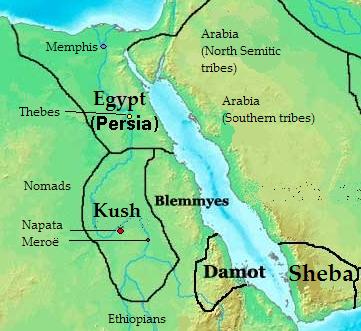Kingdom of Kush
Kingdom of Kush Kuluš | |||||||||||||
|---|---|---|---|---|---|---|---|---|---|---|---|---|---|
| 1070 BC–AD 350 | |||||||||||||
 | |||||||||||||
| Capital | Kerma; Napata; later Meroe | ||||||||||||
| Common languages | Meroitic, Nubian | ||||||||||||
| Religion | Nubian religion | ||||||||||||
| Government | Monarchy | ||||||||||||
| King | |||||||||||||
| History | |||||||||||||
• Established | 1070 BC | ||||||||||||
• Capital moved to Napata | 780 BC | ||||||||||||
• Capital moved to Meroe | 591 BC | ||||||||||||
• Disestablished | AD 350 | ||||||||||||
| Population | |||||||||||||
• Egyptian phase[1] | 100000 | ||||||||||||
• Meroite phase[1] | 1,150,000 | ||||||||||||
| |||||||||||||
| Today part of | |||||||||||||
Kush civilization had its center in the region of Nubia. This was in northern Sudan of today. We know about it through the Egyptians who moved south around 2500 BC. When the Middle Kingdom of Egypt ended, an independent kingdom of Kush developed. About 1500 BC Egyptians moved southwards again, but this time met organized resistance. Historians are not sure whether this resistance came from many city states or a single unified empire. The Egyptians won, and the region became a colony of Egypt under the control of Thutmose I. The region supplied Egypt with resources.
In the eleventh century BC internal disputes in Egypt caused colonial rule to collapse and an independent kingdom arose based at Napata in Nubia. This kingdom was ruled by locals who overthrew the colonial regime. But Kush had many beliefs and gods in common with Egypt.
In the Bible
[change | change source]The name given to this civilization comes from the Old Testament where Cush (Hebrew: כוש) was one of the sons of Ham (Son of Noah) who settled in Northeast Africa. The Bible refers to Cush on a number of occasions. Moses wife, Tzipporah, is described as a Kushite in the book of Numbers.[2]
Related pages
[change | change source]References
[change | change source]- ↑ 1.0 1.1 Stearns, Peter N., ed. (2001). "(II.B.4.) East Africa, c. 2000–332 BC". Encyclopedia of World History (6th ed.). Boston: Houghton Mifflin Harcourt. p. 32. ISBN 978-0-395-65237-4.[permanent dead link]
- ↑ Some scholars speculate that Cush is the same person as Lugalbanda in the Epic of Gilgamesh.
- Jean Leclant. "The empire of Kush: Napata and Meroe" UNESCO General History of Africa
- A. Hakem with I. Hrbek and J. Vercoutter. "The civilization of Napata and Meroe" UNESCO General History of Africa
- P.L. Shinnie. "The Nilotic Sudan and Ethiopia c. 660 BC to c. AD 600" Cambridge History of Africa - Volume 2 Cambridge University Press, 1978.
Other websites
[change | change source]- Ancient Gold Center Discovered on the Nile
- On Kush Archived 2007-05-01 at the Wayback Machine
- (in French) Voyage au pays des pharaons noirs Travel in Sudan : pictures and notes on the nubian history
- Scholars Race to Recover a Lost Kingdom on the Nile from the New York Times.
- Poplicha, Joseph (1929). "The Biblical Nimrod and the Kingdom of Eanna". Journal of the American Oriental Society. 49. American Oriental Society: 303–17. doi:10.2307/593008. ISSN 0003-0279. JSTOR 593008.